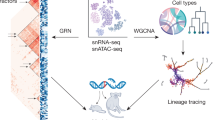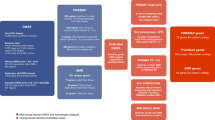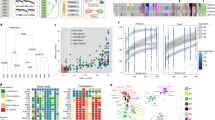Abstract
Advances in genetics and genomics have fuelled a revolution in discovery-based, or hypothesis-generating, research that provides a powerful complement to the more directly hypothesis-driven molecular, cellular and systems neuroscience. Genetic and functional genomic studies have already yielded important insights into neuronal diversity and function, as well as disease. One of the most exciting and challenging frontiers in neuroscience involves harnessing the power of large-scale genetic, genomic and phenotypic data sets, and the development of tools for data integration and mining. Methods for network analysis and systems biology offer the promise of integrating these multiple levels of data, connecting molecular pathways to nervous system function.
This is a preview of subscription content, access via your institution
Access options
Subscribe to this journal
Receive 51 print issues and online access
$199.00 per year
only $3.90 per issue
Buy this article
- Purchase on Springer Link
- Instant access to full article PDF
Prices may be subject to local taxes which are calculated during checkout



Similar content being viewed by others
References
Coppola, G. & Geschwind, D. H. Microarrays and the microscope: balancing throughput with resolution. J. Physiol. (Lond.) 575, 353–359 (2006).
Nelson, S. B., Hempel, C. & Sugino, K. Probing the transcriptome of neuronal cell types. Curr. Opin. Neurobiol. 16, 571–576 (2006).
Mirnics, K. & Pevsner, J. Progress in the use of microarray technology to study the neurobiology of disease. Nature Neurosci. 7, 434–439 (2004).
Geschwind, D. H. Mice, microarrays, and the genetic diversity of the brain. Proc. Natl Acad. Sci. USA 97, 10676–10678 (2000).
Hood, L., Heath, J. R., Phelps, M. E. & Lin, B. Systems biology and new technologies enable predictive and preventative medicine. Science 306, 640–643 (2004).
Arlotta, P. et al. Neuronal subtype-specific genes that control corticospinal motor neuron development in vivo. Neuron 45, 207–221 (2005).
Cahoy, J. D. et al. A transcriptome database for astrocytes, neurons, and oligodendrocytes: a new resource for understanding brain development and function. J. Neurosci. 28, 264–278 (2008).
Heiman, M. et al. A translational profiling approach for the molecular characterization of CNS cell types. Cell 135, 738–748 (2008).
Lobo, M. K., Karsten, S. L., Gray, M., Geschwind, D. H. & Yang, X. W. FACS-array profiling of striatal projection neuron subtypes in juvenile and adult mouse brains. Nature Neurosci. 9, 443–452 (2006).
Sugino, K. et al. Molecular taxonomy of major neuronal classes in the adult mouse forebrain. Nature Neurosci. 9, 99–107 (2006).
Emes, R. D. et al. Evolutionary expansion and anatomical specialization of synapse proteome complexity. Nature Neurosci. 11, 799–806 (2008). In this paper, a combination of genomics and proteomics is used to identify synaptic proteins that have changed with evolution and study how they might relate to brain anatomy and function.
Nagasaka, Y. et al. A unique gene expression signature discriminates familial Alzheimer's disease mutation carriers from their wild-type siblings. Proc. Natl Acad. Sci. USA 102, 14854–14859 (2005).
Nishimura, Y. et al. Genome-wide expression profiling of lymphoblastoid cell lines distinguishes different forms of autism and reveals shared pathways. Hum. Mol. Genet. 16, 1682–1698 (2007).
Karsten, S. L. et al. A genomic screen for modifiers of tauopathy identifies puromycin-sensitive aminopeptidase as an inhibitor of tau-induced neurodegeneration. Neuron 51, 549–560 (2006).
Lim, J. et al. A protein–protein interaction network for human inherited ataxias and disorders of Purkinje cell degeneration. Cell 125, 801–814 (2006).
Mirnics, K., Middleton, F. A., Marquez, A., Lewis, D. A. & Levitt, P. Molecular characterization of schizophrenia viewed by microarray analysis of gene expression in prefrontal cortex. Neuron 28, 53–67 (2000). This paper was the first to demonstrate the utility of microarray analysis to uncover new genes and properties associated with neuropsychiatric disease.
Wang, J., Williams, R. W. & Manly, K. F. WebQTL: web-based complex trait analysis. Neuroinformatics 1, 299–308 (2003).
Lein, E. S. et al. Genome-wide atlas of gene expression in the adult mouse brain. Nature 445, 168–176 (2007).
Cirelli, C., Gutierrez, C. M. & Tononi, G. Extensive and divergent effects of sleep and wakefulness on brain gene expression. Neuron 41, 35–43 (2004).
Sandberg, R. et al. Regional and strain-specific gene expression mapping in the adult mouse brain. Proc. Natl Acad. Sci. USA 97, 11038–11043 (2000).
Geschwind, D. H. Sharing gene expression data: an array of options. Nature Rev. Neurosci. 2, 435–438 (2001).
Miller, J. A., Oldham, M. C. & Geschwind, D. H. A systems level analysis of transcriptional changes in Alzheimer's disease and normal aging. J. Neurosci. 28, 1410–1420 (2008).
Oldham, M. C., Horvath, S. & Geschwind, D. H. Conservation and evolution of gene coexpression networks in human and chimpanzee brains. Proc. Natl Acad. Sci. USA 103, 17973–17978 (2006).
Oldham, M. C. et al. Functional organization of the transcriptome in human brain. Nature Neurosci. 11, 1271–1282 (2008). This paper demonstrates that the brain transcriptome in its normal state has a reproducible structure that can be used to guide discovery.
Winden, K. et al. The organization of the transcriptional network in specific neuronal classes. Mol. Syst. Biol. 5, 291 (2009).
Stuart, J. M., Segal, E., Koller, D. & Kim, S. K. A gene-coexpression network for global discovery of conserved genetic modules. Science 302, 249–255 (2003).
Lee, H. K., Hsu, A. K., Sajdak, J., Qin, J. & Pavlidis, P. Coexpression analysis of human genes across many microarray data sets. Genome Res. 14, 1085–1094 (2004).
Thompson, C. L. et al. Genomic anatomy of the hippocampus. Neuron 60, 1010–1021 (2008). This paper is an example of the power of using tools such as the ABA as a reference together with other wet-lab tools to uncover new neuroanatomical connections, in this case new hippocampal subdivisions.
Gong, S. et al. A gene expression atlas of the central nervous system based on bacterial artificial chromosomes. Nature 425, 917–925 (2003).
Okaty, B. W., Miller, M. N., Sugino, K., Hempel, C. M. & Nelson, S. B. Transcriptional and electrophysiological maturation of neocortical fast-spiking GABAergic interneurons. J. Neurosci. 29, 7040–7052 (2009).
Doyle, J. P. et al. Application of a translational profiling approach for the comparative analysis of CNS cell types. Cell 135, 749–762 (2008).
Cowley, M. J. et al. Intra- and inter-individual genetic differences in gene expression. Mamm. Genome 20, 281–295 (2009).
Nadler, J. J. et al. Large-scale gene expression differences across brain regions and inbred strains correlate with a behavioral phenotype. Genetics 174, 1229–1236 (2006).
Johnson, M. B. et al. Functional and evolutionary insights into human brain development through global transcriptome analysis. Neuron 62, 494–509 (2009).
Kislinger, T. et al. Global survey of organ and organelle protein expression in mouse: combined proteomic and transcriptomic profiling. Cell 125, 173–186 (2006).
Brunner, E. et al. A high-quality catalog of the Drosophila melanogaster proteome. Nature Biotechnol. 25, 576–583 (2007).
Fernandez, E. et al. Targeted tandem affinity purification of PSD-95 recovers core postsynaptic complexes and schizophrenia susceptibility proteins. Mol. Syst. Biol. 5, 269 (2009).
Anderson, C. N. & Grant, S. G. High throughput protein expression screening in the nervous system — needs and limitations. J. Physiol. (Lond.) 575, 367–372 (2006).
Husi, H., Ward, M. A., Choudhary, J. S., Blackstock, W. P. & Grant, S. G. Proteomic analysis of NMDA receptor–adhesion protein signaling complexes. Nature Neurosci. 3, 661–669 (2000).
Takamori, S. et al. Molecular anatomy of a trafficking organelle. Cell 127, 831–846 (2006).
Trinidad, J. C. et al. Quantitative analysis of synaptic phosphorylation and protein expression. Mol. Cell. Proteomics 7, 684–696 (2008).
Croning, M. D., Marshall, M. C., McLaren, P., Armstrong, J. D. & Grant, S. G. G2Cdb: the Genes to Cognition database. Nucleic Acids Res. 37, D846–D851 (2009).
Magdaleno, S. et al. BGEM: an in situ hybridization database of gene expression in the embryonic and adult mouse nervous system. PLoS Biol. 4, e86 (2006).
Zapala, M. A. et al. Adult mouse brain gene expression patterns bear an embryologic imprint. Proc. Natl Acad. Sci. USA 102, 10357–10362 (2005).
Valor, L. M., Charlesworth, P., Humphreys, L., Anderson, C. N. & Grant, S. G. Network activity-independent coordinated gene expression program for synapse assembly. Proc. Natl Acad. Sci. USA 104, 4658–4663 (2007). This paper exemplifies the combination of multiple layers of functional data — in this case neuronal activity recordings and morphological measurements — with gene expression data to directly uncover how changes in function and gene expression relate to each other over time.
Cheung, V. G. et al. Mapping determinants of human gene expression by regional and genome-wide association. Nature 437, 1365–1369 (2005).
Chesler, E. J. et al. Complex trait analysis of gene expression uncovers polygenic and pleiotropic networks that modulate nervous system function. Nature Genet. 37, 233–242 (2005). This paper provides an early example of combining data across multiple levels of function, factoring genotypes, phenotypes and gene expression in mouse to identify systems-level interactions.
Hovatta, I. et al. DNA variation and brain region-specific expression profiles exhibit different relationships between inbred mouse strains: implications for eQTL mapping studies. Genome Biol. 8, R25 (2007).
Ghazalpour, A. et al. Integrating genetic and network analysis to characterize genes related to mouse weight. PLoS Genet. 2, e130 (2006).
Chen, Y. et al. Variations in DNA elucidate molecular networks that cause disease. Nature 452, 429–435 (2008).
van der Zwaag, B. et al. Gene-network analysis identifies susceptibility genes related to glycobiology in autism. PLoS ONE 4, e5324 (2009).
Webster, J. A. et al. Genetic control of human brain transcript expression in Alzheimer disease. Am. J. Hum. Genet. 84, 445–458 (2009).
Myers, A. J. et al. A survey of genetic human cortical gene expression. Nature Genet. 39, 1494–1499 (2007).
Marioni, J. C., Mason, C. E., Mane, S. M., Stephens, M. & Gilad, Y. RNA-seq: an assessment of technical reproducibility and comparison with gene expression arrays. Genome Res. 18, 1509–1517 (2008).
Liu, F. et al. Comparison of hybridization-based and sequencing-based gene expression technologies on biological replicates. BMC Genomics 8, 153 (2007).
Preuss, T. M., Caceres, M., Oldham, M. C. & Geschwind, D. H. Human brain evolution: insights from microarrays. Nature Rev. Genet. 5, 850–860 (2004).
Barabási, A. L. & Oltvai, Z. N. Network biology: understanding the cell's functional organization. Nature Rev. Genet. 5, 101–113 (2004).
Jeong, H., Tombor, B., Albert, R., Oltvai, Z. N. & Barabási, A.-L. The large-scale organization of metabolic networks. Nature 407, 651–654 (2000). This paper is a seminal demonstration of the higher-order organization of metabolism across phylogeny.
Zhang, B. & Horvath, S. A general framework for weighted gene co-expression network analysis. Stat. Appl. Genet. Mol. Biol. 4, 17 (2005).
Khaitovich, P. et al. A neutral model of transcriptome evolution. PLoS Biol. 2, e132 (2004).
Lam, Y. C. et al. ATAXIN-1 interacts with the repressor Capicua in its native complex to cause SCA1 neuropathology. Cell 127, 1335–1347 (2006).
Canterini, S., Bosco, A., De Matteis, V., Mangia, F. & Fiorenza, M. T. THG-1pit moves to nucleus at the onset of cerebellar granule neurons apoptosis. Mol. Cell. Neurosci. 40, 249–257 (2009).
Bilder, R. M. et al. Phenomics: the systematic study of phenotypes on a genome-wide scale. Neuroscience doi:10.1016/j.neuroscience.2009.01.027 (20 January 2009).
Rzhetsky, A. et al. GeneWays: a system for extracting, analyzing, visualizing, and integrating molecular pathway data. J. Biomed. Inform. 37, 43–53 (2004).
Rodriguez-Esteban, R., Iossifov, I. & Rzhetsky, A. Imitating manual curation of text-mined facts in biomedicine. PLoS Comput. Biol. 2, e118 (2006).
Iossifov, I., Zheng, T., Baron, M., Gilliam, T. C. & Rzhetsky, A. Genetic-linkage mapping of complex hereditary disorders to a whole-genome molecular-interaction network. Genome Res. 18, 1150–1162 (2008).
Rzhetsky, A., Wajngurt, D., Park, N. & Zheng, T. Probing genetic overlap among complex human phenotypes. Proc. Natl Acad. Sci. USA 104, 11694–11699 (2007). This paper demonstrates that with enough phenotypic information it is possible to build modelling networks that predict the underlying genetic overlap among neuropsychiatric diseases with previously distinct aetiologies.
Bullmore, E. & Sporns, O. Complex brain networks: graph theoretical analysis of structural and functional systems. Nature Rev. Neurosci. 10, 186–198 (2009).
Honey, C. J., Kotter, R., Breakspear, M. & Sporns, O. Network structure of cerebral cortex shapes functional connectivity on multiple time scales. Proc. Natl Acad. Sci. USA 104, 10240–10245 (2007).
Rilling, J. K. et al. The evolution of the arcuate fasciculus revealed with comparative DTI. Nature Neurosci. 11, 426–428 (2008).
Mischel, P. S., Cloughesy, T. F. & Nelson, S. F. DNA-microarray analysis of brain cancer: molecular classification for therapy. Nature Rev. Neurosci. 5, 782–792 (2004).
Tang, Y., Lu, A., Aronow, B. J. & Sharp, F. R. Blood genomic responses differ after stroke, seizures, hypoglycemia, and hypoxia: blood genomic fingerprints of disease. Ann. Neurol. 50, 699–707 (2001).
Thomas, E. A. et al. The HDAC inhibitor 4b ameliorates the disease phenotype and transcriptional abnormalities in Huntington's disease transgenic mice. Proc. Natl Acad. Sci. USA 105, 15564–15569 (2008).
Day, A., Carlson, M. R., Dong, J., O'Connor, B. D. & Nelson, S. F. Celsius: a community resource for Affymetrix microarray data. Genome Biol. 8, R112 (2007).
McDowall, M. D., Scott, M. S. & Barton, G. J. PIPs: human protein–protein interaction prediction database. Nucleic Acids Res. 37, D651–D656 (2009).
Kamburov, A., Wierling, C., Lehrach, H. & Herwig, R. ConsensusPathDB — a database for integrating human functional interaction networks. Nucleic Acids Res. 37, D623–D628 (2009).
Chatr-Aryamontri, A., Zanzoni, A., Ceol, A. & Cesareni, G. Searching the protein interaction space through the MINT database. Methods Mol. Biol. 484, 305–317 (2008).
Mathivanan, S. et al. An evaluation of human protein-protein interaction data in the public domain. BMC Bioinformatics 7 (suppl. 5), S19 (2006).
Foster, L. J. et al. A mammalian organelle map by protein correlation profiling. Cell 125, 187–199 (2006).
Mathivanan, S. et al. Human Proteinpedia enables sharing of human protein data. Nature Biotechnol. 26, 164–167 (2008).
Linsen, S. E. et al. Limitations and possibilities of small RNA digital gene expression profiling. Nature Methods 6, 474–476 (2009).
Passalacqua, K. D. et al. Structure and complexity of a bacterial transcriptome. J. Bacteriol. 191, 3203–3211 (2009).
Acknowledgements
This Review would not have been possible without help from members of the Geschwind laboratory, especially G. Coppola, who helped with several figures and provided critical comments on the manuscript; M. Oldham, for his pioneering use of WGCNA in the brain; and D. Crandall of the Mental Retardation Research Centre media core at the University of California, Los Angeles, for assistance with Fig. 3. We are also grateful to our collaborators S. Horvath, S. Nelson and P. Mischel, for their generosity of time and expertise. We apologize to the authors of the many outstanding studies we were not able to cite owing to space limitations. We acknowledge support from the US National Institutes of Health (grants NIMH R37 MH60233-06A1 and NINDS U24 NS52108), the US National Institute on Aging, and the Dr Miriam & Sheldon G. Adelson Medical Research Foundation programme on neural repair and rehabilitation for our work in functional genomics (D.H.G.); and the A. P. Giannini Foundation Medical Research Foundation and NARSAD (G.K.).
Author information
Authors and Affiliations
Ethics declarations
Competing interests
Competing interests: D.H.G. is on the Scientific Advisory Board of the Human Brain Atlas project of the Allen Institute for Brain Science, which is a non-profit organization.
Additional information
Reprints and permissions information is available at http://www.nature.com/reprints.
Correspondence should be addressed to D.H.G. (dhg@ucla.edu).
Rights and permissions
About this article
Cite this article
Geschwind, D., Konopka, G. Neuroscience in the era of functional genomics and systems biology. Nature 461, 908–915 (2009). https://doi.org/10.1038/nature08537
Published:
Issue Date:
DOI: https://doi.org/10.1038/nature08537
This article is cited by
-
Transcription factor network analysis identifies REST/NRSF as an intrinsic regulator of CNS regeneration in mice
Nature Communications (2022)
-
Kcnn2 blockade reverses learning deficits in a mouse model of fetal alcohol spectrum disorders
Nature Neuroscience (2020)
-
Stress genomics revisited: gene co-expression analysis identifies molecular signatures associated with childhood adversity
Translational Psychiatry (2020)
-
Active State Organization of Spontaneous Behavioral Patterns
Scientific Reports (2018)
-
Convergent Pathways in Idiopathic Autism Revealed by Time Course Transcriptomic Analysis of Patient-Derived Neurons
Scientific Reports (2018)
Comments
By submitting a comment you agree to abide by our Terms and Community Guidelines. If you find something abusive or that does not comply with our terms or guidelines please flag it as inappropriate.



